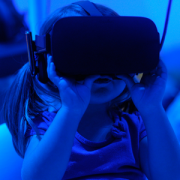We are seeing lots of developments involving the application of virtual reality (VR), extended reality (XR), and augmented reality in healthcare and medicine. VR healthcare companies are using these technologies to create virtual environments where patients and caregivers can participate in highly immersive experiences designed to simulate various healthcare scenarios and needs. Key application areas include education/training, treatment, and physical therapy/rehabilitation.
Companies are implementing virtual technologies in conjunction with artificial intelligence (AI), gamification techniques, and analytics. The aim is to facilitate platforms that provide highly realistic, interactive, and engaging experiences for the intended user — whether a patient or caregiver. The embedding of analytics within these offerings enables users (e.g., patients, physicians, nurses, mental health counselors, physical therapists) and care-providing organizations to accurately track and measure the user’s progress in meeting their goals — whether it is recovering from an injury or illness or learning a new care practice or medical procedure.
This Advisor series looks at the use of VR in healthcare and medicine. In Part I, we examined how companies are using VR technologies to develop applications for healthcare educational and training purposes. Here in Part II, we continue our coverage by examining developments involving the use of VR for treatment, therapy, and rehabilitation.
VR for Treatment, Therapy & Rehabilitation
Although not as common as VR applications for education and training in healthcare, the development and use of VR technologies for treatment, therapy, and rehabilitation is increasing. Such applications range from VR platforms designed to help patients manage specific diseases and injuries to programs for reducing patient anxiety before and during surgery. We are also seeing organizations conducting clinical trials to examine the possibility of using VR as an adjunct to anesthesia in surgery. The following are some representative examples of VR treatment, therapy, and rehabilitation applications currently available or in some stage of development or testing.
Treating Patients with Stroke and Brain Injuries with VR-Based Rehabilitation
NeuroReality offers a cognitive training program that combines VR, AI, and gamification to create an immersive experience designed to treat individuals suffering from stroke and brain injuries. The program functions by guiding patients through activities planned to help them regain functionality required for everyday activities. It employs the concept of neuroplasticity where, through the use of mental and physical exercises and new learned experiences, it is possible to create and reorganize connections and pathways in the brain, thus making it possible for patients to relearn how to undertake activities they were able to perform prior to becoming injured.
The cognitive training program is intended for patients suffering from a brain injury or cognitive deficits such as a stroke, post-concussion syndrome, or for someone suffering from brain fog related to Long COVID or lack of oxygen (e.g., near drowning, suffocation). Rehabilitation exercises focus specifically on improving attention (divided and selective), executive functioning, visual spatial skills, reaction time, accuracy, memory, and numerical manipulation.
Recently XRHealth, a provider of therapeutic programs utilizing VR and AR technology, licensed NeuroReality’s cognitive training program for use in its own virtual clinics, which provide comprehensive therapeutic care for patients to receive rehabilitation, cognitive assessment, pain management, and other treatments from home. Using the NeuroReality training modules with the XRHealth platform involves a patient being guided by virtual assistants through the various rehabilitation exercises in a personalized manner. Training modules employ a dynamic difficulty progression algorithm that auto-adjusts tasks (i.e., making them easier/more difficult) based on the user’s progress. Patients can visualize their progress via a dashboard. And clinicians can analyze patient data in real time to monitor their progress and to tailor treatments to a patient’s specific rehabilitation needs.
Easing Patient Surgery Anxiety
The degree of anxiety felt by patients prior to undergoing a medical procedure can vary significantly, with some patients experiencing considerable fear. VR healthcare companies view this as a very applicable target for applying their technology, and a number are developing solutions for this problem.
Reducing Stress for Pediatric Patients Before Surgery
Pre-medical procedure anxiety can be especially high among children. A 2020 study in Pediatric Health, Medicine and Therapeutics reports that 50%-75% of pediatric patients suffer from preoperative stress.
Saritasa and Before, Inc. are developing a VR platform designed to get children comfortable with medical procedures before surgery. The application provides an immersive VR walkthrough of medical procedures, in effect, giving young patients a virtual dress rehearsal for their upcoming medical procedures. The aim is to enable children and their families to experience what will happen on the day of surgery so they won’t be so freaked out when they actually enter the operating room (e.g., to become familiar with the medical equipment and devices that will be used in the operating room in order to alleviate their anxiety and the fear of the unknown). The platform is currently in prototype and is available for testing and feedback with children’s hospitals and clinics.
Reducing Stress as Well as the Use of Anesthesia During Surgery
The results of a clinical trial published in PLOS ONE demonstrated that VR therapy may serve as an effective adjunct to anesthesia used in surgery. This trial involved 34 patients undergoing hand and wrist surgery. All of the patients were administered a peripheral nerve block before surgery. Patients were randomized to intraoperative immersive VR with intravenous anesthesia only provided when needed or as directed by an anesthesiologist.
Patients wore VR headsets running XRHealth’s VR program, which provided an immersive environment designed to engage and guide them through relaxation and pain-reduction techniques while undergoing surgery (see Figure 1). XRHealth provided free use of the VR software and hardware required for the trial.
.png)
The results of the trial showed that the majority of patients (13 out of 17) using VR did not need any intravenous sedatives during surgery. A postoperative survey demonstrated similarly low levels of pain and anxiety for patients in both control groups. Additionally, secondary findings demonstrated that patients using the VR recovered from anesthesia more quickly and left the recovery room earlier than those in the usual care group. This trial appears to be generating a lot of interest due to the possibility of VR not only being able to serve as a useful adjunct to anesthesia during surgical procedures but also for its use in managing pain and speeding recovery.
Conclusion
VR technologies are now beginning to find use in healthcare scenarios. The applications and products discussed in this Advisor by no means represent all those available or in development. However, I do believe they are representative of the important VR healthcare development trends now taking place in the industry.
Currently, education and training comprise the majority of VR applications in healthcare. That said, the development and use of VR technologies for treatment, therapy, and rehabilitation are growing. The bottom line is that we should expect the use of VR technologies in healthcare to increase over the foreseeable future as providers continue expanding on their digital health initiatives — which really took off during the height of the COVID pandemic — by implementing VR technologies into their operations in order to cut costs, alleviate skilled staffing shortages, improve patient outcomes, and better the customer experience. Part III of this series continues this conversation by taking a closer look at digital humans and their role in healthcare and wellness.
Finally, I’d like to get your opinion on the application of VR in healthcare and medicine as well as its use in other industries. As always, your comments will be held in strict confidence. You can email me at experts@cutter.com or call +1 510 356 7299 with your comments.



